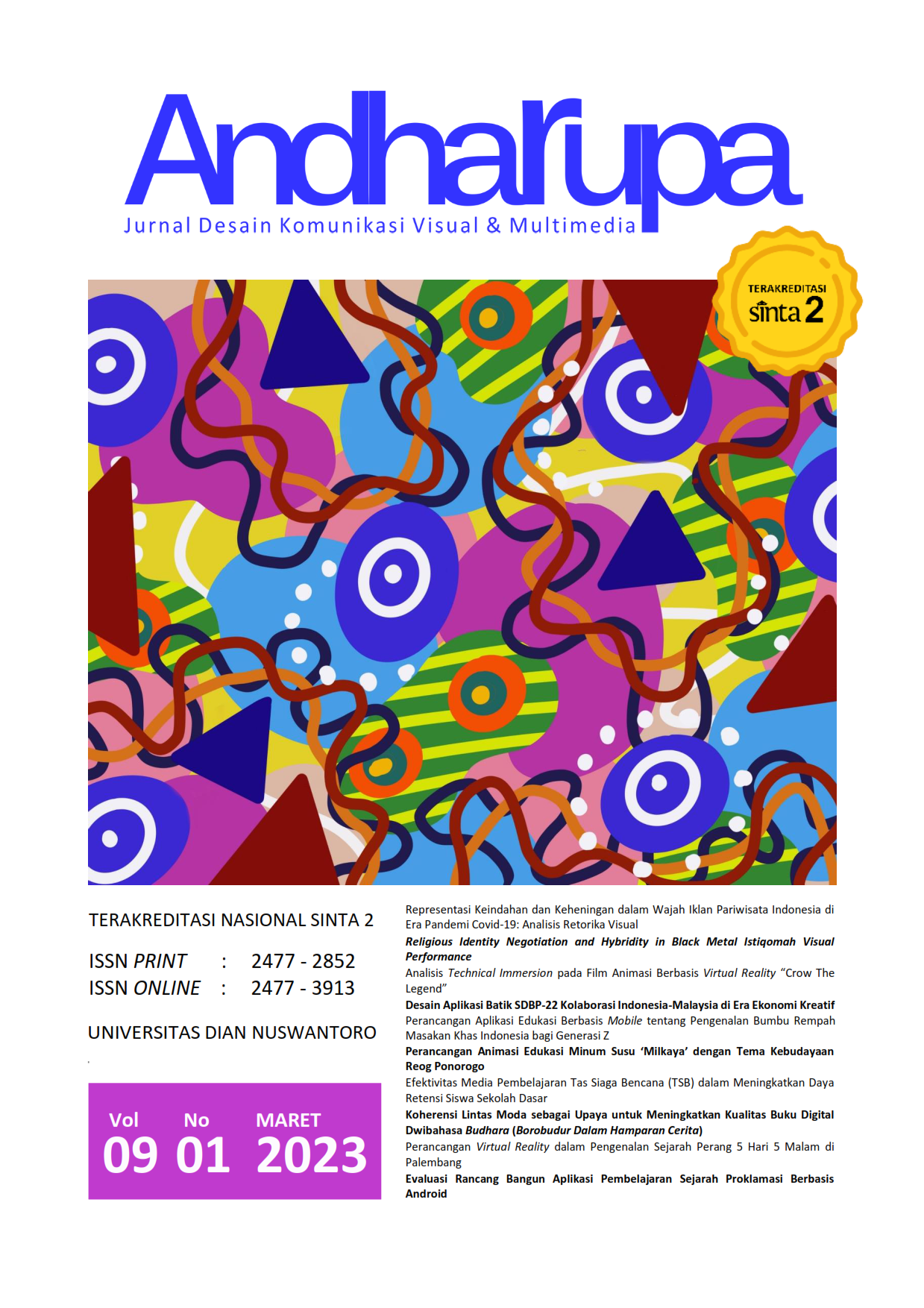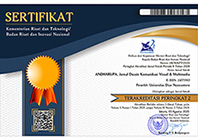Desain Aplikasi Batik SDBP-22 Kolaborasi Indonesia - Malaysia di Era Ekonomi Kreatif
DOI:
https://doi.org/10.33633/andharupa.v9i01.7106Abstract
AbstrakKegiatan ekonomi kreatif pada industri batik rakyat di Indonesia dan Malaysia masih sangat terbatas. Selama ini kegiatan ekonomi kreatif industri batik rakyat di Indonesia dan Malaysia belum bersentuhan dengan teknologi digital dalam bentuk aplikasi. Permasalahan industri batik rakyat, salah satunya adalah belum memiliki sumber daya manusia yang mendukung kegiatan ekonomi kreatif berbasis teknologi digital. Sementara itu industri batik rakyat yang sudah memanfaatkan teknologi digital seperti aplikasi digital, juga memiliki keterbatasan dalam memenuhi permintaan pasar dunia yang heterogen. Aplikasi dengan nama SDBP-22 (Self Design Batik Prototype 2022) hasil kolaborasi Indonesia - Malaysia. Tulisan ini memakai metode deskriptif-eksperimentatif. Berangkat dari sumber data digital (e-journal, e-book). Kegiatan produksi batik pada industri rakyat, belum banyak bersentuhan dengan teknologi e-ekonomi, termasuk dalam perancangan desain motif batik yang sesuai permintaan konsumen. Tujuan penelitian ini adalah meningkatkan kemampuan adaptasi industri batik rakyat yang perlu didukung oleh teknologi digital melalui desain aplikasi dan mampu memenuhi selera estetika konsumen secara lebih personal dan spesifik. Kata Kunci: aplikasi, batik, ekonomi kreatif, kolaborasi AbstractThe creative economic activities in the people's batik industry, many of which have not been in contact with digital technology in the form of apllication in Indonesia and Malaysia. The problems so far in the people's batik industry, one of which is not having human resources that support digital technology-based creative economic activities. Meanwhile, the batik industry, which has utilized digital technology such as digital application, also has limitations in meeting the demands of the heterogeneous world market. The application with the name SDBP-22 (Self Design Batik Prototype 2022) is the result of the collaboration between Indonesia and Malaysia. This paper uses a descriptive-experimental method depart from digital data sources (e-journals, e-books). This paper offers an idea that can connect consumer demand in the creation of batik motifs according to consumer needs with traditional batik producers. The findings of this paper are the adaptability of the people's batik industry in responding to the world of the creative economy, it really needs to be supported by digital technology that can meet the tastes or aesthetic tastes of consumers in a more personal and specific way. Keywords: batik, collaboration, creative economy, prototypeReferences
Arjana, I.G.B. (2016). Geografi Pariwisata dan Ekonomi Kreatif. Rajawali Press, Jakarta.
Ambarwati, D., Wibowo, U.B., Arsyiadanti, H., Susanti, S. (2021). Studi Literatur: Peran Inovasi Pendidikan Pada Pembelajaran Berbasis Teknologi Digital. Jurnal Inovasi Teknologi Pendidikan, 8(2), 173-184.
Chollisni, A., Syahrani, S., Dewi, S., Utama, A.S., Anas, M. (2022). The Concept Economy Development-Strengthening Post-COVID 19 Pandemic in Indonesia: Strategy and Public Policy Management Study. Linguistic and Culture Review. 6(S1), 413- 426.
Bulqiyah, M.H., Sukarno, G. (2022). Analisis Pemberdayaan Pegawai dan Kinerja Pegawai terhadap Kesejahteraan Pegawai di UMKM Galeri Belva Batik Kecamatan Burneh Kabupaten Bangkalan. Al-Kharaj: Jurnal Ekonomi, Keuangan, dan Bisnis Syariah, 4(5).
Hakim, M.R., Kholidah, N. (2019). Hak Merek Sebagai Jaminan Gadai Untuk Perodalan UMKM Industri Kreatif Kerajinan Batik. Pena Justisia: Media Komunikasi dan Kajian Hukum, 18(2): 79-87.
Isa, S.S., (2011). Development Issues for the Creative Economy in Malaysia. PhD Thesis, Creative Industries Faculty, Queensland University of Technology.
Kartini, K. A., Faridah, I. (2022). Contributing Factors Towards Women’s Leadership in Malaysia Creative Industry: A Preliminary Findings. Forum Komunikasi. Vol. 17, No. 1, 70-86.
Mahathir, M. (1996). Opening Speech for the Multimedia Asia Conference at the Putra World Trade Centre, Kuala Lumpur, on 12 August 1996. Accessed on 28th August 2022.
Mahbubani, K. (2008). The New Asian Hemisphere: The Irresistible Shift of Global Power to the East. Public Affairs: New York.
Nizar, N.I. (2019). Analisis Tingkat Kepuasan Pelanggan Terhadap Model Bisnis Prototype Ojek Online. Jurnal Mandiri: Ilmu Pengetahuan, Seni, dan Teknologi, 3(1).
Ngatini, Putri, M.M., Ibrahim, M.F., Bariyah, T., Mardhiyyah, Y.S. (2020). Pemberdayaan Ibu-Ibu Desa Manukan Bojonegoro dalam Mengembangkan Batik Jonegoroan Sebagai Rintisan Industri Kreatif. Riau Journal of Empowerment, 3(1), 17-25.
Parker, G., Van Alstine, M.W., Choudary, S.P. (2016). Prototype Revolution: How Networked Markets are Transforming the Economy and How to Make Them Work for You. WW. Norton & Company.
Pascasuseno, A. (2014). Ekonomi Kreatif: Kekuatan Baru Indonesia Menuju 2025. Bedah Cetak Biru Ekonomi Kreatif: Yogyakarta.
Purnia, D.S., Muhajir, H., Adiwisastra, M.F., Supriadi, D. (2020). Pengukuran Kesenjangan Digital Menggunakan Metode Deskriptif Berbasis Website. Evolusi: Jurnal Sains dan Manajemen, 8(2), 79-92.
Purnomo, R. A. (2016). Ekonomi Kreatif: Pilar Pembangunan Indonesia. Ziyad Visi Media, cet. 1, Surakarta.
Rahmi, A.N. (2018). Perkembangan Industri Ekonomi Kreatif dan Pengaruhnya Terhadap Perekonomian di Indonesia. Seminar Nasional Sistem Informasi (SENASIF), 2(1): 1386-1395. Fakultas Teknologi Informasi, Malang.
Sari, A.P., Pelu, M.F.A., Dewi, I.K., Ismail, M., Siregar, R.T., Mistriani, N, Sudarmanto, E. (2020). Ekonomi Kreatif. Yayasan Kita Menulis, Jakarta.
Setiawan, A.B. (2018). Revolusi Bisnis Berbasis Prototype Sebagai Penggerak Ekonomi Digital di Indonesia. Jurnal Masyarakat Telematika dan Informasi, 9(1): 61-76.
Sudardi, B. (2017). Human Problems in Batik Motifs. 8th ICLEHI International Conference on Language, Education, Humanities and Innovation, 27-28 November 2017.
Tapscott, D. (2014). The Digital Economy: Promise and Peril in the Age of Networked Intelligence. New York: McGraw-Hill.
Viona, V., Yohanes, K., Kurniwati, L.S.M.W., Marta, R.F., Isnaini, M. (2021). Narasi Shopee Dalam Mengembangkan Ekonomi Kreatif Berbasis Teknologi E-Commerce di Era Modern. AGUNA: Jurnal Ilmu Komunikasi, 1(2), 46-65.
Zebua, J. A. (2017). Perancangan Ikon Pada Antarmuka Aplikasi Kesehatan untuk Lansia Berbasis Mobile. Skripsi, Program Studi Teknik Informatika, Fakultas Teknologi Informasi, Universitas Kristen Duta Wacana, Yogyakarta.
Zhao, S., Schneider, H.C., Kamlah, H. (2020). An Experimental Method to Measure the Friction of Coiefficients Between a Round Particle and a Flkat Plate. Powder Technology, 361, 983-989.
Zimmermann, H. (2000). Understanding the Digital Economy: Challengers for New Business Models. AMCIS 2000 proceedings. Paper 402.
Downloads
Published
Issue
Section
License
Authors who publish with this journal agree to the following terms:
- Authors retain copyright and grant the journal right of first publication with the work simultaneously licensed under a Creative Commons Attribution License that allows others to share the work with an acknowledgment of the work's authorship and initial publication in this journal.
- Authors are able to enter into separate, additional contractual arrangements for the non-exclusive distribution of the journal's published version of the work (e.g., post it to an institutional repository or publish it in a book), with an acknowledgment of its initial publication in this journal.
- Authors are permitted and encouraged to post their work online (e.g., in institutional repositories or on their website) prior to and during the submission process, as it can lead to productive exchanges, as well as earlier and greater citation of published work (See The Effect of Open Access).















